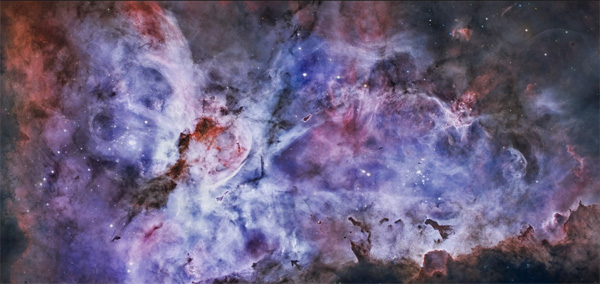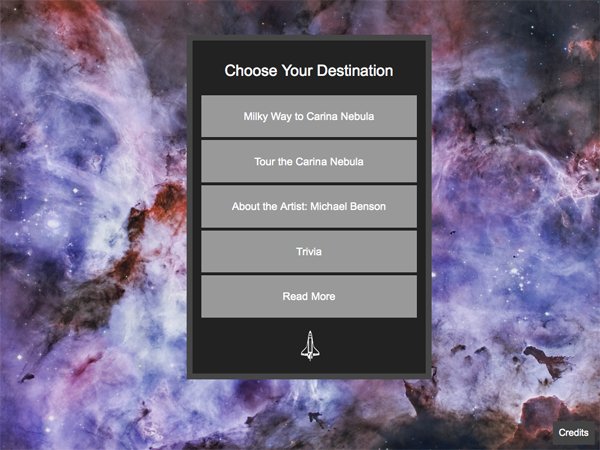Carina Nebula

Carina Nebula Hubble Space Telescope, March and July 2005, and European Southern Observatory 2.2 meter telescope, La Silla, Chile, 1999, 2000, 2001, 2003. Image created by Michael Benson in 2008 by combining data from the NASA-ESA Hubble Space Telescope and from the European Southern Observatory 2.2 meter telescope, La Silla, Chile. Chromogenic print, 2012 Stoddard Acquisition Fund, 2013.4
An exhibit that's out of this world - Worcester Telegram and Gazette
January - June 22, 2014
This Jeppson Idea Lab project introduces a photograph of the Carina Nebula printed exclusively for WAM and acquired for the collection in 2013. It represents a unique point of contact between contemporary art and science. One of the overriding questions provoked by viewing this image in an art museum is, “When is data art?” It is a question that is closely tied to the history of photography and the evolving role of technology in image production. While humans have been fascinated with the sky since prehistory, a vista with this level of detail has only been available to us quite recently. This seamless photographic mosaic combines the talents and imaginations of astronomers and engineers using both space and land-based telescopes with sophisticated cameras, and artist Michael Benson.
The Carina Nebula, an area of space about 10,000 light years away, is among the brightest parts of the Milky Way visible from Earth. It is an area teeming with new and dying stars - clouds of dust and gas, eroding dust pillars sculpted by radiation from powerful stars, and lobes of stellar material.
Working with archives primarily used by planetary scientists and astronomers, Benson’s explorations are focused on aesthetic, not scientific discoveries. Taking raw image data acquired for research purposes, Benson edits, combines, composites, and repurposes it for his photography. Due to the limitations of our visible light spectrum, official image releases from the Hubble Space Telescope are frequently presented in “representative” colors. These colors are quite different from the actual hues humans would be able to perceive if looking upon the Carina Nebula themselves.
In order to better represent how the human eye might see the nebula—albeit enhanced by the power of the telescope to gather vastly more light than our unassisted senses ever could—Benson has replaced the false-color information of the original Hubble image with true-color data derived from lower-resolution Earth-based observations. In this way, he retains the incomparable detail of the Hubble mosaic composite while enhancing Carina Nebula’s color accuracy by utilizing the visible-light wavelength observations recorded by the European Southern Observatory between 1999 and 2003.
About the artist:
Michael Benson, a photographer, writer and filmmaker, is widely recognized for bringing the visual legacy of space exploration to public view in photography exhibitions and books. Beyond: Visions of the Interplanetary Probes (2003), his internationally best-selling book of photographs derived from digital data collected by space agencies,was developed into an exhibition by the Smithsonian Institution and was presented at WAM in 2009. Additional publications include Far Out: A Space-Time Chronicle (2009) and Planetfall: New Solar System Visions (2012). Apart from his own award-winning films, Benson has worked with director Terence Malick to help realize space sequences in the film Tree of Life, which won the Palm d’Or at the Cannes Film Festival in 2011, and his work has also appeared in Chilean filmmaker Patricio Guzmán’s 2011 feature documentary Nostalgia for the Light. He currently lives in West Somerville, and is working at MIT on a project titled Nanocosmos.
Interactive

About the Jeppson Idea Lab
An exciting collection initiative, the Jeppson Idea Lab takes place in the Jeppson gallery located on the 3rd level and is dedicated to highlighting single objects (or small groups of objects) from the permanent collection. Rather than presenting a formal thesis, which is more often the case for exhibitions, the Idea Lab will be a public forum for sharing questions about objects that may lead to future exhibitions, reattributions, or publications. Idea Lab objects are being chosen by conservators, educators, and curators. Platforms for visitors to explore ideas raised by the objects will be video interviews and iPad interactive activities with links to related materials. The Idea Lab will change every 6 months.

 Sign up for WAM eNews
Sign up for WAM eNews